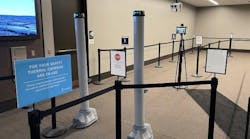A radiation sensor inside a cell phone was used with a network of tiny computers spread out around Vanderbilt Stadium on Thursday to detect a fake radioactive "dirty bomb."
The experiment was a test of a system that could represent a leap forward in homeland security technology, said researchers from Vanderbilt University and Oak Ridge National Laboratory who have been working jointly on the project.
On Thursday they set their equipment up in the stadium press box and watched as a red dot moved across their computer screens.
The dot represented the real-time movements of researcher Janos Sallai as he walked up and down the stadium seats and around the playing field while watching the radiation sensor inside his cell phone.
He was searching for a small bit of real radioactive material hidden in a briefcase among the bleachers - a stand-in for a dirty bomb that would use conventional explosives to spew radioactive material across a populated area.
A sudden downburst of hail and intermittent showers on Thursday threw the researchers some curveballs, but overall the system functioned as it was supposed to.
"The rain killed some of our equipment," Vanderbilt scientist Akos Ledeczi said.
Tiny radio-transmitting computers spaced around an area, like Vanderbilt Stadium, can be used to help security workers find potential threats, such as the fake radioactive bomb Thursday.
The computers, called nodes, are square white boxes with a short antenna protruding from the top. The current device is no bigger than a coffee cup, but future versions may be the size of buttons on an overcoat.
"It will be miniaturized as the technology matures," Ledeczi said.
The nodes feed information from sensors like the one in the researcher's cell phone back to computers being monitored by the researchers. In a real-world application, the information would be sent to computers used by security personnel.
The nodes can also be used to instantly train security cameras with almost pinpoint accuracy to the site of trouble, Ledeczi said. That ability has already drawn the interest of the Pentagon for its ability to detect snipers.
Oak Ridge National Laboratory scientist Frank DeNap said the technology the team is developing will be versatile enough to detect more than just radioactive threats.
"It will work with any type of sensor," he said. "If the threat is chemical, you can use a chemical sensor. Or, if you think the threat is explosives, you can use an explosives sensor."
Ledeczi said practical use of such a threat detection system could be about a year away.
___
On the Net:
Vanderbilt University's Institute for Software Integrated Systems: http://www.isis.vanderbilt.edu/
Oak Ridge National Laboratory: http://www.ornl.gov


